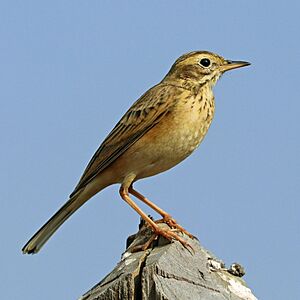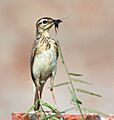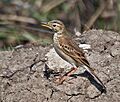Paddyfield pipit facts for kids
Quick facts for kids Paddyfield pipit |
|
|---|---|
 |
|
| A. r. rufulus Kanha National Park, Madhya Pradesh, India |
|
| Conservation status | |
| Scientific classification | |
| Genus: |
Anthus
|
| Species: |
rufulus
|
| Synonyms | |
|
Corydalla rufula |
|
The paddyfield pipit or Oriental pipit (Anthus rufulus) is a small passerine bird. It belongs to the pipit and wagtail family. This bird lives all year round in open areas. You can find it in grasslands, farms, and scrubland across southern Asia and east to the Philippines. It is one of the few pipits that breed in Asia. However, it can be hard to tell apart from other pipits that visit in winter.
Contents
What Does It Look Like?
This pipit is about 15 centimeters (6 inches) long. It looks quite plain, mostly streaky grey-brown on top. Its belly is pale with streaks on its chest. It has long legs and a long tail. Its bill is long and dark. Both male and female birds look similar. Their feathers look the same in summer and winter.
Young birds have richer colors on their undersides. They also have pale edges on their upper feathers. This makes the spots on their chest stand out more. Some groups of these birds look a bit different depending on where they live. For example, birds from north-western India are paler. Those from the Western Ghats are larger and darker.
How to Tell It Apart from Other Pipits
In winter, other pipits fly into the area. It can be tricky to tell them apart from the paddyfield pipit. These include Richard's pipit and Blyth's pipit. The paddyfield pipit is smaller and looks a bit chunkier. It also has a shorter-looking tail. Its flight is weaker and more fluttery.
The paddyfield pipit makes a special "chip-chip-chip" sound. This is different from the loud "shreep" of Richard's pipit. It also sounds different from the nasal "pschreen" of Blyth's pipit. The tawny pipit has fewer streaks on its back. It also has a black stripe near its eye and a longer tail.
Bird Families and Names
Scientists group animals into families and species. The paddyfield pipit has been grouped with other pipits over time. Its scientific name has changed a few times. It can be hard to identify these birds just from museum samples. This is because their colors and shapes change with age and location.
Today, six main types (subspecies) are part of this species. They are found in different parts of Asia. For example, one type lives in most of the Indian Subcontinent. Another type lives in the Philippines. Others are found in places like Sulawesi and Timor. Some experts even think the paddyfield pipit might be a type of Richard's pipit.
Life and Habits
The paddyfield pipit lives in open areas. It especially likes short grasslands and farmlands. It often walks on bare ground. This bird runs very fast on the ground. If it gets scared and flies, it does not go very far.
Reproduction and Nesting
Paddyfield pipits can breed all year. However, they mostly do so during the dry season. A pair of birds might raise two or more groups of young in a year. When it's time to breed, the male bird sings. It repeats a note as it flies down from a short, fluttery flight. This flight is usually just a few feet above the ground.
The nest is built on the ground. It is often hidden under a small bump, a clump of grass, or near a bush. The birds weave their nests from grass and leaves. They are usually shaped like a cup. If a nest is out in the open, it might have a dome shape. This is when long grass covers the top. The inside of the nest is lined with finer grass or roots.
A female bird usually lays three or four eggs. The eggs are greenish with many small brown spots. These spots are usually at the wider end. If something bothers them near the nest, the birds will flutter nearby. They make weak "tsip-tsip-tsip" calls. Parent birds might also pretend to be hurt. This helps to distract animals that might try to eat their eggs or young.
Paddyfield pipits mostly eat small insects. They also eat larger beetles, tiny snails, and worms. They find this food while walking on the ground. They might also chase insects like mosquitoes or termites in the air. Sometimes, tiny mites can cause skin problems on their legs.
Gallery
-
Carrying food for young (Kolkata, West Bengal, India
-
An individual with lesions on the legs (Purbasthali, West Bengal
-
Cup shaped nest with three eggs from Hoskote near Bangalore, India
-
Dome shaped nest from Hoskote near Bangalore, India
-
Wide-span flying Paddyfield pipit from Dhaka, Bangladesh
-
Paddyfield pipit, taken at Basai wetlands, Haryana
-
Paddyfield Pipit seen in Udumalpet, Tamil Nadu, India












